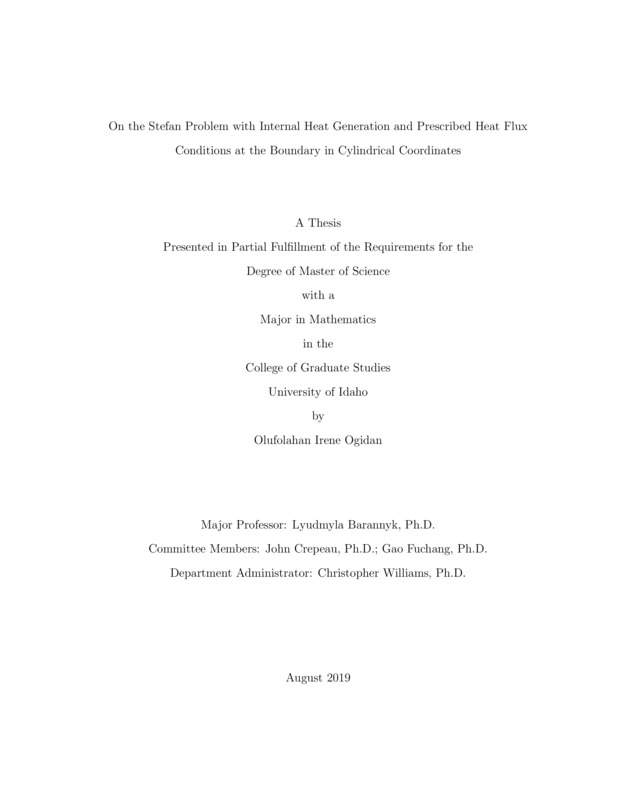On the Stefan Problem with Internal Heat Generation and Prescribed Heat Flux Conditions at the Boundary in Cylindrical Coordinates
Ogidan, Olufolahan Irene. (2019-08). On the Stefan Problem with Internal Heat Generation and Prescribed Heat Flux Conditions at the Boundary in Cylindrical Coordinates. Theses and Dissertations Collection, University of Idaho Library Digital Collections. https://www.lib.uidaho.edu/digital/etd/items/ogidan_idaho_0089n_11670.html
- Title:
- On the Stefan Problem with Internal Heat Generation and Prescribed Heat Flux Conditions at the Boundary in Cylindrical Coordinates
- Author:
- Ogidan, Olufolahan Irene
- Date:
- 2019-08
- Program:
- Mathematics
- Subject Category:
- Applied mathematics
- Abstract:
-
My thesis focuses on the evolution of the solid-liquid interface during melting and
solidication in a material with constant internal heat generation and prescribed heat
ux
at the boundary in a cylinder. A phase change process in which a material transitions
between two phases, solid and liquid, is known as a Stefan moving boundary problem.
We assume that the internal heat generation is constant and the same in both phases.
The material properties in both phases are also taken to be constant and equal. We assume
that the heat is transferred only by conduction and we neglect convection in the liquid phase.
In addition, we assume that there is a sharp interface between two phases where the phase
changes at a single melting temperature and there is no mushy zone at the interface. The
presence of the internal heat generation makes the problem nonhomogeneous. Starting from
the heat conduction equation, the approach nds steady-state and transient temperature
solutions in each phase and employs the separation of variables technique to nd transient
solutions. A nonlinear rst-order dierential equation with Fourier-Bessel series terms is
derived for the time-dependent motion of the interface. Analytic solutions for temperature
proles in each phase are derived. We do not introduce the Stefan number since there is only
one xed temperature: melting temperature. Instead we introduce dimensionless heat
ux
at the boundary. The initial value problem is solved numerically, and solutions compared to
the previously derived quasi-steady ones. It is shown that when the internal heat generation
and the heat
ux at the boundary have a close range of values, it takes longer for the front
to reach steady state than when the values are farther apart. As the dierence between
the internal heat generation and the
ux increases, the transient solution becomes more
dominant and the numerical solution of the phase change front does not reach steady-state
before the outer boundary or centerline is reached. This shows that the prescribed heat
ux can be used as a parameter that controls the motion of the interface. The problem has
applications for a nuclear fuel rod during meltdown.
- Description:
- masters, M.S., Mathematics -- University of Idaho - College of Graduate Studies, 2019-08
- Major Professor:
- Barannyk, Lyudmyla
- Committee:
- Crepeau, John; Gao, Fuchang
- Defense Date:
- 2019-08
- Identifier:
- Ogidan_idaho_0089N_11670
- Type:
- Text
- Format Original:
- Format:
- application/pdf
- Rights:
- In Copyright - Educational Use Permitted. For more information, please contact University of Idaho Library Special Collections and Archives Department at libspec@uidaho.edu.
- Standardized Rights:
- http://rightsstatements.org/vocab/InC-EDU/1.0/

